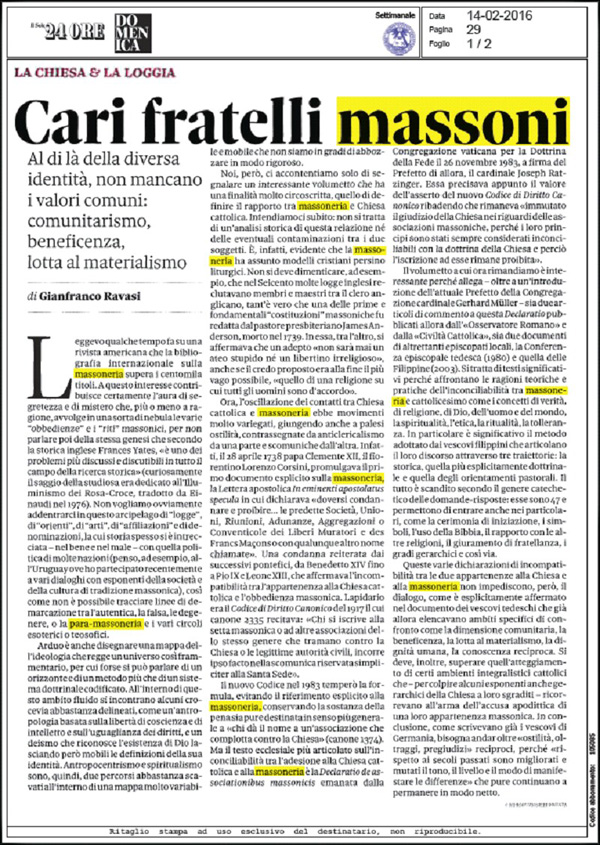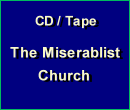Documents for your files
 |
PROGRESSIVIST DOCUMENT OF THE WEEK
Card. Ravasi: ‘Dear Masonic Brothers’
Card. Giafranco Ravasi is the President of the Pontifical Council for Culture. Speaking as an important member of the Hoy See, he took the initiative of writing a letter to his “dear Masonic brothers.”
To consider the Freemasons as “brothers” is in itself more important than any part of the letter. It is an new official treatment - similar to “separated brothers” for Protestants or “elder brothers” for the Jews. And as with these two latter enemies of the Church, we are now witnessing a similar thaw of the Church's multi-century old hostility toward the Masons.
It has been a long and sad walk of the Conciliar Popes, who have praised the ideals of Freemasonry – liberty, equality, fraternity, human rights etc. – as well as made repeated visits to the seat of the UN, which is a consubstantiation of the One World Order, another goal of Masonry.
We have seen also Catholic Prelates in different parts of the world visiting Masonic Lodges and delivering talks in them.
Now, we see the Holy See officially writing to the Freemasons and addressing them as “brothers.” It is a new landmark that should be noted and recorded.
Below, we present a photocopy of the letter by Card. Ravasi taken from an organ of Freemasonry – the periodical 24 Ore (24 Hours).
Above the letter in Italian, we present its full translation to English in blue print.
To consider the Freemasons as “brothers” is in itself more important than any part of the letter. It is an new official treatment - similar to “separated brothers” for Protestants or “elder brothers” for the Jews. And as with these two latter enemies of the Church, we are now witnessing a similar thaw of the Church's multi-century old hostility toward the Masons.
It has been a long and sad walk of the Conciliar Popes, who have praised the ideals of Freemasonry – liberty, equality, fraternity, human rights etc. – as well as made repeated visits to the seat of the UN, which is a consubstantiation of the One World Order, another goal of Masonry.
We have seen also Catholic Prelates in different parts of the world visiting Masonic Lodges and delivering talks in them.
Now, we see the Holy See officially writing to the Freemasons and addressing them as “brothers.” It is a new landmark that should be noted and recorded.
Below, we present a photocopy of the letter by Card. Ravasi taken from an organ of Freemasonry – the periodical 24 Ore (24 Hours).
Above the letter in Italian, we present its full translation to English in blue print.
24 Hours - Sunday
February 14, 2016
The Church & the Lodge
Dear Masonic Brothers
Gianfranco Ravasi
I read some time ago in an American magazine that the international bibliography on Freemasonry has more than 120,000 titles. Certainly contributing to this interest is the aura of secrecy and mystery that, with more or less objectivity, wraps in a sort of cloud the various masonic "obediences" and "rituals," not to speak of its very origin, which, according to English historian Frances Yates, "is one of the more discussed and discussable problems in the whole field of historical research" (curiously, the scholar's essay was about the Rosicrusian Enlightenment - translated by the publisher Einaudi in 1976).
We do not want to enter into this archipelago of "lodges," "orients," "arts," "affiliations" and denominations in which its history often is interweaved - for good or evil - with the politics of many nations. (I think, for example, of Uruguay where I recently participated in several dialogues with spokespersons on the society and culture of masonic tradition.) Nor is it possible to draw boundary lines between the authentic, the false, the degenerate or the para-Masonry and the various esoteric or theosophical centers.
It is also difficult to draw a map of the ideology that governs so fragmentary a universe, and, for this reason, perhaps we could speak of a horizon and method rather than a codified doctrinal system. Within this fluid ambience, there are some defined crossroads, such as an anthropology based on liberty of conscience, understanding and equal rights, and a Theism that recognizes the existence of God, leaving flexible, however, the definition of his identity. Anthropocentrism and spiritualism are, therefore, two heavily travelled roads on a quite variable and mobile map that we are not in conditions to sketch in detail.
We are pleased, however, to report an interesting booklet that has the circumscribed end of defining the relationship between Masonry and the Catholic Church. Let us make ourselves understood at once: It is not a historical analysis of this relationship nor of the mutual influences between the two subjects. It is in fact evident that Masonry assumed Christian models, even liturgical ones. We should not forget that in the 1600s many English lodges recruited members and masters among the Anglican clergy, and to such a degree that one of the first fundamental masonic "constitutions" was written by the Presbyterian pastor Jarnes Anderson, who died in 1739. In it, among other things, it is affirmed that an adept "will never be a stupid atheist nor an irreligious libertine," although the creed proposed at the end is the most vague possible, "that of a religion upon which all men can be in agreement."
Now then, the back-and-forth in contacts between the Catholic Church and Masonry has had diverse movements, to the point of an overt hostility, marked by anti-clericalism on the one side and excommunication on the other. In fact, on April 28, 1738, Pope Clement XII, the Florentine Lorenzo Corsini, promulgated the first explicit document about Masonry, the Apostolic Letter In eminenti apostolatus specula, in which he declared, "We must condemn and prohibit ... the mentioned Societies, Companies, Assemblies, Meetings, and Gatherings of the Free Workers, Freemasons or whatever other name they may be called."
This condemnation was repeated by the successive Pontiffs from Benedict XIV to Pius IX and Leo XIII, who affirmed the incompatibility of belonging to the Catholic Church and the Masonic obedience. The Code of Canon Law of 1917 was crystal clear; its canon 2335 read: "Whoever is inscribed in the Masonic sect or other associations of the same genre that plot against the Church or the legitimacy of the civil authority, incurs an automatic excommunication that can only be absolved by the Holy See."
The New Code of 1983 tempered the formula by avoiding explicit reference to Masonry and conserving the substance of the penalty. It referred, however, more generically to "those who join an association that plots against the Church" (canon 1374).
But the better articulated text about the incompatibility between the adhesion to the Catholic Church and the Masonry is the Declaratio de associationibus massonicis issued by the Vatican Congregation for the Faith on November 26, 1983, signed by its then Prefect, Card. Joseph Ratzinger. It stressed the tenets of the new Code of Canon Law affirming that the judgment of the Church regarding masonic associations remains unchanged because their principles were always considered incompatible with Church doctrine and because joining them remains prohibited."
The booklet we mentioned above is interesting because it includes - besides an introduction by the present day Prefect of the Congregation Card. Gerhard Muller - two articles commenting on this Declaratio published by L'Osservatore Romano and Civiltà Cattolica, as well as two documents by local Episcopates, the German Conference of Bishops (1980) and that of the Philippines (2003). These are significant texts since they address the theoretical and practical reasons for the incompatibility of Masonry and Catholicism, such as their conceptions of truth, religion, God, man and the world, spirituality, ethics, rituals and tolerance.
Particularly significant is the method adopted by the Philippine Bishops who articulate their discourse on three pathways: the historical, the more explicitly doctrinal and the pastoral. The entire work is presented in a catechetical question-answer genre. There are 47 altogether, and they enter into details such as the ceremony of initiation, the symbols, the use of the Bible, the relationship with other religions, the oath of brotherhood, the degrees of the hierarchy, and so on.
These various declarations of incompatibility between belonging to the Church and Masonry do not prevent, however, a dialogue, as is explicitly affirmed in the document of the German Bishops, who listed specific fields of collaboration, such as the communitarian dimension, philanthropic works, the fight against materialism, human dignity and mutual understanding.
Furthermore, one must transcend the approach of certain Catholic integrist ambiences which - to attack various members of the Hierarchy whom they dislike - apodictically accuse them of belonging to Masonry. In conclusion, as the German Bishops have written, it is necessary to go beyond reciprocal "hostility, insults and prejudices," because "in the last century, there have been improvements in the tone, level and way of manifesting differences," which nonetheless continue to exist in a clear way.
The Church & the Lodge
Dear Masonic Brothers
Gianfranco Ravasi
I read some time ago in an American magazine that the international bibliography on Freemasonry has more than 120,000 titles. Certainly contributing to this interest is the aura of secrecy and mystery that, with more or less objectivity, wraps in a sort of cloud the various masonic "obediences" and "rituals," not to speak of its very origin, which, according to English historian Frances Yates, "is one of the more discussed and discussable problems in the whole field of historical research" (curiously, the scholar's essay was about the Rosicrusian Enlightenment - translated by the publisher Einaudi in 1976).
We do not want to enter into this archipelago of "lodges," "orients," "arts," "affiliations" and denominations in which its history often is interweaved - for good or evil - with the politics of many nations. (I think, for example, of Uruguay where I recently participated in several dialogues with spokespersons on the society and culture of masonic tradition.) Nor is it possible to draw boundary lines between the authentic, the false, the degenerate or the para-Masonry and the various esoteric or theosophical centers.
It is also difficult to draw a map of the ideology that governs so fragmentary a universe, and, for this reason, perhaps we could speak of a horizon and method rather than a codified doctrinal system. Within this fluid ambience, there are some defined crossroads, such as an anthropology based on liberty of conscience, understanding and equal rights, and a Theism that recognizes the existence of God, leaving flexible, however, the definition of his identity. Anthropocentrism and spiritualism are, therefore, two heavily travelled roads on a quite variable and mobile map that we are not in conditions to sketch in detail.
We are pleased, however, to report an interesting booklet that has the circumscribed end of defining the relationship between Masonry and the Catholic Church. Let us make ourselves understood at once: It is not a historical analysis of this relationship nor of the mutual influences between the two subjects. It is in fact evident that Masonry assumed Christian models, even liturgical ones. We should not forget that in the 1600s many English lodges recruited members and masters among the Anglican clergy, and to such a degree that one of the first fundamental masonic "constitutions" was written by the Presbyterian pastor Jarnes Anderson, who died in 1739. In it, among other things, it is affirmed that an adept "will never be a stupid atheist nor an irreligious libertine," although the creed proposed at the end is the most vague possible, "that of a religion upon which all men can be in agreement."
Now then, the back-and-forth in contacts between the Catholic Church and Masonry has had diverse movements, to the point of an overt hostility, marked by anti-clericalism on the one side and excommunication on the other. In fact, on April 28, 1738, Pope Clement XII, the Florentine Lorenzo Corsini, promulgated the first explicit document about Masonry, the Apostolic Letter In eminenti apostolatus specula, in which he declared, "We must condemn and prohibit ... the mentioned Societies, Companies, Assemblies, Meetings, and Gatherings of the Free Workers, Freemasons or whatever other name they may be called."
This condemnation was repeated by the successive Pontiffs from Benedict XIV to Pius IX and Leo XIII, who affirmed the incompatibility of belonging to the Catholic Church and the Masonic obedience. The Code of Canon Law of 1917 was crystal clear; its canon 2335 read: "Whoever is inscribed in the Masonic sect or other associations of the same genre that plot against the Church or the legitimacy of the civil authority, incurs an automatic excommunication that can only be absolved by the Holy See."
The New Code of 1983 tempered the formula by avoiding explicit reference to Masonry and conserving the substance of the penalty. It referred, however, more generically to "those who join an association that plots against the Church" (canon 1374).
But the better articulated text about the incompatibility between the adhesion to the Catholic Church and the Masonry is the Declaratio de associationibus massonicis issued by the Vatican Congregation for the Faith on November 26, 1983, signed by its then Prefect, Card. Joseph Ratzinger. It stressed the tenets of the new Code of Canon Law affirming that the judgment of the Church regarding masonic associations remains unchanged because their principles were always considered incompatible with Church doctrine and because joining them remains prohibited."
The booklet we mentioned above is interesting because it includes - besides an introduction by the present day Prefect of the Congregation Card. Gerhard Muller - two articles commenting on this Declaratio published by L'Osservatore Romano and Civiltà Cattolica, as well as two documents by local Episcopates, the German Conference of Bishops (1980) and that of the Philippines (2003). These are significant texts since they address the theoretical and practical reasons for the incompatibility of Masonry and Catholicism, such as their conceptions of truth, religion, God, man and the world, spirituality, ethics, rituals and tolerance.
Particularly significant is the method adopted by the Philippine Bishops who articulate their discourse on three pathways: the historical, the more explicitly doctrinal and the pastoral. The entire work is presented in a catechetical question-answer genre. There are 47 altogether, and they enter into details such as the ceremony of initiation, the symbols, the use of the Bible, the relationship with other religions, the oath of brotherhood, the degrees of the hierarchy, and so on.
These various declarations of incompatibility between belonging to the Church and Masonry do not prevent, however, a dialogue, as is explicitly affirmed in the document of the German Bishops, who listed specific fields of collaboration, such as the communitarian dimension, philanthropic works, the fight against materialism, human dignity and mutual understanding.
Furthermore, one must transcend the approach of certain Catholic integrist ambiences which - to attack various members of the Hierarchy whom they dislike - apodictically accuse them of belonging to Masonry. In conclusion, as the German Bishops have written, it is necessary to go beyond reciprocal "hostility, insults and prejudices," because "in the last century, there have been improvements in the tone, level and way of manifesting differences," which nonetheless continue to exist in a clear way.






